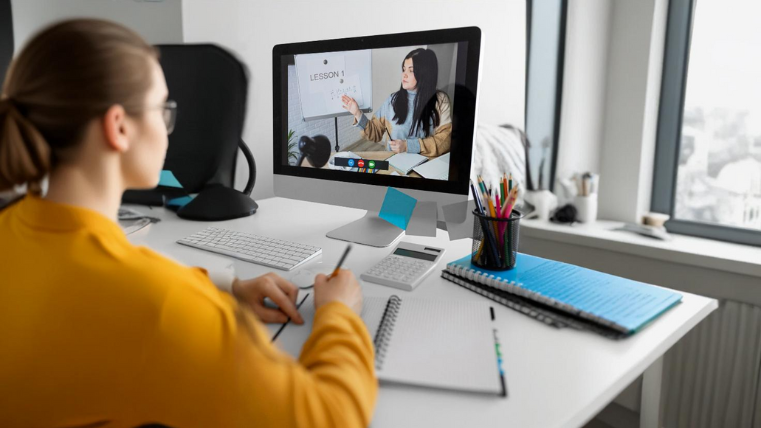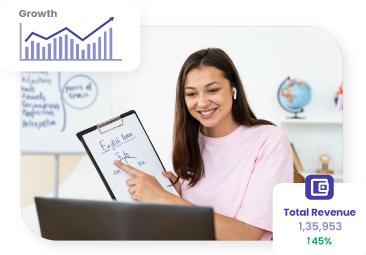Many online course creators struggle to turn interest into actual sales. You’ve poured your heart into creating valuable content, but potential students hesitate to enroll. Why? Because in a crowded market, trust is hard to earn.
That’s where webinars come in as a powerful tool. A well-planned webinar isn’t just a presentation; it’s a live, interactive experience for students. It allows you to directly address concerns, showcase your expertise, and build a connection with your audience that a sales page simply can’t replicate.
This guide provides the actionable strategies you need to transform your webinars from simple introductions into effective enrollment drivers. Learn how to structure your content, engage your audience, and close the deal, so you can turn webinar attendees into paying students.
Why Are Webinars a Great Option to Sell Your Online Courses?
Most online course sales fall through not because of a lack of interest but because potential students hesitate to take action. Webinars change this by creating an environment where learning and decision-making happen in the same space. Instead of relying on multiple marketing touchpoints, a well-planned webinar guides attendees through the buying process in real-time.
By presenting value in a structured, interactive way, webinars remove distractions, clear doubts instantly, and turn engaged viewers into paying students, all within a single session.
Here’s what makes webinars so powerful for selling online courses:
- Webinars Create an Instant Buying Environment
Most online courses rely on long sales funnels, but webinars compress decision-making into a single session. When attendees commit 45+ minutes to a live event, they are already psychologically invested, making them 5x more likely to buy compared to passive website visitors.
- They Bypass the ‘Too Many Options’ Problem
One of the biggest reasons people hesitate to buy a course? Choice overload. With thousands of options online, potential students procrastinate and never decide. Webinars eliminate distractions by offering a focused, guided buying experience where attendees see real-time value without comparison shopping.
- Live Q&A Converts Hesitation into Action
Traditional sales pages can’t answer last-minute doubts. A webinar allows instructors to clear objections on the spot, addressing real concerns in real-time, which increases conversions.
- Webinars Attract Serious Buyers, Not Just Browsers
Signing up for a webinar takes commitment, meaning attendees are already engaged. Live interaction helps them ask questions, clear doubts, and see the course in action, making enrollment a natural next step.
- They Turn ‘Cold Traffic’ into High-Trust Buyers Faster
Most marketing strategies take weeks or months to build trust. A well-structured webinar can do it in one hour by offering live interaction, direct teaching, and visible student success stories, all of which accelerate buying decisions.
Webinars don’t just inform, they create a space for real-time connection and decision-making. By engaging directly with potential students, you’re not just selling a course, you’re guiding them toward a confident “yes.” To turn that engagement into actual enrollments, every part of your webinar, from the content to the follow-up, needs to be structured with sales in mind. Here’s how to do it effectively.
Want to make your webinars a way to connect with potential students and turn them into paying students? Consider how Exly can help you host, manage, and grow your online business through webinars. With tools that assist with hosting and payment processing, Exly can help you engage attendees and guide them toward enrollment. Get started for free!
How to Use Webinars to Sell Courses
Webinars work best when every part of the session guides attendees toward taking action. Instead of just sharing information, a well-planned webinar builds engagement, addresses doubts as they come up, and presents an offer in a way that feels natural. Getting these elements right makes a direct impact on course sales. Here are some ways how to use webinars to sell courses:
1. Offer a Time-Sensitive Discount That Feels Personalized
Creating urgency works, but generic discounts don’t always convert. Instead of offering a flat 20% discount, frame the offer as a personalized incentive to encourage immediate action.
Data-Driven Strategy: Studies show that limited-time bonuses perform better than discounts. So, instead of saying, “Get 20% off,” say:
- “Enroll today and get an exclusive one-on-one feedback session with me.”
- “Join within the next 24 hours and receive a private Q&A call with past successful students.”
Why it works: This creates scarcity without devaluing the course price, making attendees feel like they’re getting an exclusive opportunity rather than just a discount.
2. Keep Your Offer Visible Without Overwhelming Attendees
Most course creators only mention their offer at the end, this is a mistake. Instead, incorporate subtle yet frequent reminders throughout the webinar to keep the course top-of-mind.
- Pre-Webinar Teaser: Before the webinar starts, display a slide that says, “Stay until the end for a special live bonus.”
- Midway Soft Mention: After sharing a student success story, naturally link it to the course (“[Student Name] applied this exact strategy from my program, and look where they are today.”)
- Closing CTA Strategy: Keep the offer on-screen while answering Q&A. This extends the purchase decision window instead of rushing it at the last minute.
3. Filter Your Leads Before the Webinar
The biggest reason webinars fail? The wrong audience. Simply promoting the webinar on social media platforms isn’t enough. You need to attract leads who are already interested in course topics.
- Expert Tactic: Use content-driven lead magnets to qualify webinar attendees in advance.
- Example: Instead of just running “Sign up for my webinar” ads, promote a mini-guide or checklist related to the course topic. Once someone downloads it, invite them to the webinar.
Why this works:
- People who consume pre-webinar content are 2.5x more likely to purchase.
- You avoid cold leads who register just out of curiosity but won’t buy.
4. Follow Up with Registrants Based on Engagement, Not Just Attendance
Most course creators send the same follow-up email to everyone. This is a missed opportunity. Instead, segment follow-ups based on how attendees engaged with the webinar.
- Attended + Engaged: Send a direct checkout link with a reminder of the webinar’s key takeaways.
- Attended But Didn’t Buy: Send an email with a recording and highlight the most important 5 minutes to re-engage interest.
- Registered But Didn’t Attend: Send a short, casual email: “Hey [First Name], I noticed you missed the session. No worries! Here’s a 10-minute highlight reel so you can catch up fast.”
Why this works:
- Personalized follow-ups feel less like sales emails and more like helpful reminders, increasing response rates.
- Engaged attendees are already interested, so sending a direct checkout link makes it easier for them to take action.
- Highlighting key moments from the webinar re-engages those who attended but didn’t buy, bringing their focus back to the offer.
5. Use Student Stories the Right Way
Simply displaying testimonials on a slide won’t convince attendees to buy. The key is to showcase real student transformations in a way that resonates with your audience.
- Live Guest Appearance: Instead of just quoting a student, invite them to join the webinar for a quick 5-minute conversation. Let them share their journey, challenges, and how the course helped them achieve their goals. Seeing a real person succeed makes the impact feel more tangible.
- The Before & After Storytelling Approach: Instead of broad statements like “This course changed my life,” structure the testimonial like this:
- “Before this course, I was stuck trying to grow my online business without a strategy. Now, I’ve landed three paying clients and made my first $5,000.”
Why this works:
- Attendees relate to students who started where they are now.
- Seeing real progress helps remove doubts about whether the course will work for them.
- Hearing someone else’s success makes the decision feel less risky.
6. Show Outcomes, Not Just Course Features
Listing course features doesn’t motivate buyers. Connecting features to real-world outcomes does. Instead of just telling attendees what they’ll get, show them what they’ll be able to do with it. Some examples:
- “Includes 10 live coaching calls.”
- “By the third coaching call, you’ll have launched your first paid ad with expert feedback.”
- “This course has 20 modules on digital marketing.”
- “After completing Module 4, you’ll know how to write an ad script that attracts high-quality leads.”
Why this works:
- People buy results, not lesson plans.
- Tying course content to actionable wins makes the investment feel justified.
- Attendees can visualize exactly what they’ll achieve.
7. Keep Attendees Engaged with Smart Polling
Webinars should never feel like one-sided lectures. Keeping attendees engaged increases the chances they’ll stay until the end, where the course offers are presented.
- Strategic Polls That Lead to the Sale:
- “What’s stopping you from launching your first course? (A) Time (B) Fear of failure (C) Marketing.”
- Why this works: Attendees reflect on their struggles, which sets up the course as the solution.
- “How much would earning an extra $1,000/month from your course impact you?”
- Attendees envision the course’s impact, making the price feel like an investment, not an expense.
8. Remove Price Barriers with Flexible Payment Plans
For higher-priced courses, the biggest roadblock isn’t interest, it’s affordability. Instead of reducing your price, offer payment flexibility so cost doesn’t become an obstacle.
Payment Options That Convert More Buyers:
- One-time payment (For those who want the best value upfront)
- 3-month installment plan (Makes the course accessible without a discount)
- Early-bird scholarship option (Creates urgency and rewards quick decision-makers)
Why this works:
- People prefer payment plans over one-time fees.
- Payment flexibility reduces hesitation while maintaining course value.
9. Repurpose Your Webinar for Ongoing Sales
A webinar should never be a one-time event. Once you’ve hosted a great session, repurpose it into different formats so it continues generating sales without extra effort.
Ways to Extend the Webinar’s Lifespan:
- Create a 10-minute highlight reel for YouTube, optimized with course-related keywords.
- Break it into short clips for Instagram, TikTok, and LinkedIn, each ending with a CTA to the course.
- Turn it into an evergreen webinar funnel, allowing new leads to watch the replay and access the course at any time.
Why this works:
- Recorded webinars can sell courses on autopilot.
- Short-form clips drive new leads without needing new content.
- Evergreen replays convert new audiences who couldn’t attend live.
10. Use Social Proof Immediately After the Webinar
The best time to showcase social proof is right after the webinar, while interest is still high. If attendees see others taking action, they’ll be more likely to follow through on the purchase.
How to Use Social Proof Right After the Webinar:
- Share positive chat messages from the live session as testimonials.
- Post a recap on social media: “Just wrapped up today’s webinar, so many great questions! Here’s what attendees had to say…”
- Send a follow-up email featuring students who have already enrolled: “Hundreds have joined, don’t miss your chance to be part of this group!”
Why this works:
- People are more likely to buy when they see others doing the same.
- Real-time validation creates FOMO (fear of missing out), leading to faster decisions.
Every part of a webinar, from the way you engage attendees to how you present your offer, shapes the outcome. A strong structure keeps interest high and makes the buying decision feel like a natural next step. But even the best strategy depends on the right tools.
Best Webinar Platforms to Choose From
The platform you use plays a big role in how smoothly your webinar runs and how well you can interact with your audience.
Choosing the right one ensures a seamless experience for both you and your attendees. Here’s a look at the best options:
| Features | Exly | Thinkific | Udemy | Skillshare | Teachable | Podia | Kajabi |
| Course Creation Tools | ✔️ | ✔️ | ✔️ | ✔️ | ✔️ | ✔️ | ✔️ |
| Built-in Marketing Features | ✔️ | ✔️ | ❌ | ❌ | ✔️ | ✔️ | ✔️ |
| Custom Branding Options | ✔️ | ✔️ | ❌ | ❌ | ✔️ | ✔️ | ✔️ |
| Payment Processing | ✔️ | ✔️ | ✔️ | ❌ | ✔️ | ✔️ | ✔️ |
| Live Class Support | ✔️ | ✔️ | ❌ | ❌ | ❌ | ✔️ | ✔️ |
| Community Engagement Features | ✔️ | ✔️ | ❌ | ✔️ | ❌ | ✔️ | ✔️ |
| Analytics Dashboard | ✔️ | ✔️ | ❌ | ❌ | ✔️ | ✔️ | ✔️ |
Final Thoughts
Webinars aren’t just another way to sell courses, they create a direct path from engagement to enrollment when executed the right way. The ability to interact live, handle objections instantly, and guide potential students toward a decision makes them one of the most reliable methods for course sales.
Knowing how to use webinars to sell courses effectively means focusing on the details, from structuring the content to keeping the offer visible at the right moments. Every element should work toward one goal: turning interest into action.
Creators who master this approach don’t just sell more courses, they build a loyal audience that continues to return for future programs. Now is the time to refine your strategy and use webinars to create consistent, scalable course sales.
Hosting webinars is one thing, turning them into consistent course sales is another. Exly helps course creators go beyond just presenting by providing the tools to convert attendees into paying students effortlessly.
- Zoom Integration: Host live webinars directly through Exly with auto-generated Zoom links, simplifying the setup process.
- Customizable Booking and Scheduling: Manage your webinar schedules effortlessly with Exly’s smart scheduler, allowing clients to book sessions in seconds.
- Automated Customer Engagement: Enhance the attendee experience by automating course reminders and updates, ensuring participants stay informed and engaged.
- Integrated Payment Processing: Collect payments seamlessly with support for various methods, including UPI, debit cards, credit cards, net banking, and wallets.
- Advanced Marketing Tools: Utilize Exly’s marketing suite to analyze performance, offer promotions, optimize SEO, and more, helping you attract and retain students.
By using Exly’s robust features, you can transform your webinars into effective sales channels, streamline your operations, and focus on delivering valuable content to your audience. Sign up for free!
FAQs on How to Use Webinars to Sell Courses
1. Can I pre-record my webinar and still make it feel live?
Yes, many course creators use pre-recorded webinars with live chat to engage attendees in real-time. This lets you scale while still giving the feel of a live session. Knowing how to use webinars to sell courses efficiently means balancing automation with personal interaction.
2. What’s the best way to keep attendees engaged until the course is offered?
Break up your content with interactive polls, Q&A sessions, and chat prompts every 10-15 minutes. Keeping engagement high is key when learning how to use webinars to sell courses successfully.
3. How do I structure my webinar so attendees stay until the end?
Start with a clear roadmap of what they’ll learn, deliver high-value insights early, and tease an exclusive offer they’ll get if they stay. The right structure is crucial when figuring out how to use webinars to sell courses effectively.
4. What’s the best way to follow up after a webinar for more conversions?
Send a personalized recap email within 24 hours, including the webinar replay and a limited-time bonus. Smart follow-ups are a major part of how to use webinars to sell courses without losing interested leads.
5. How long should a webinar be to maximize course sales?
A 45-60 minute webinar works best, enough time to provide value while keeping attention high. Timing plays a big role in how to use webinars to sell courses efficiently without losing attendees before the pitch.





